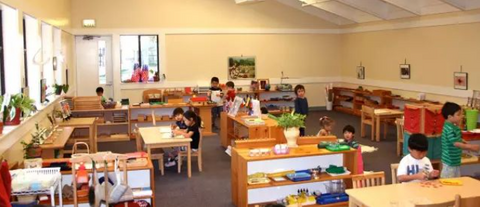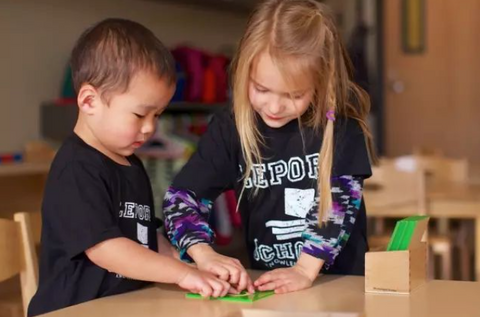Montessori is an educational method named after the Italian Maria Montessori.
Montessori was an M.D., the first female doctor in Italian history.
1907 The world's first Montessori children's home was opened in Rome.
Sounds fancy, doesn't it?
Instead, Montessori was invited to build a daycare center for a factory owner who was worried that the children of his workers would destroy his building.
And the place where the daycare center was located was called SAN Lorenzo, which in Italy at the time was a real ghetto.
There were no funds, no trained teachers, and only two uneducated women to look after the children. Montessori had nothing, and all the conditions made it seem like it had nothing to do with running a school.
And this is a group of unhappy children, a group of seriously unattended children.
In today's point of view, this is Dr. Meng to remote village left-behind children's school volunteer teaching ah.
But it was under these circumstances that Montessori began her own experiment.
What happened next shocked the world -- the children in the children's home, all of them progressed very quickly.
Not only the academic results, but also the internal changes of the child.
Montessori wrote in her book Secrets of Childhood: "They seem to know what they want, have a sense of order, and put things where they belong. They repeat, over time, and they start to become calm, confident, happy children."
Meaningful activities
It's boring to talk about educational concepts, so let's start with a picture of a Montessori classroom.
I don't know about you guys, but when I first saw this, it got me thinking.
Where is the blackboard? Where are the neatly arranged desks? And most importantly, where is the teacher?
And what are the contents of those lockers?
In a Montessori environment, there are no big blackboards for teachers to talk to, no neat rows of desks. In this picture, you can't even see the teacher.
What are the children doing in the classroom?
They were working with the teaching AIDS from the locker.
In a Montessori setting, we call the process by which the child manipulates these AIDS "work."
This "work" is different from what we adults mean by "work." You can think of it as "meaningful activity."
Take the daily living area for example.
Daily work in the living area develops children's motor coordination, concentration and independence.
In this area, children also acquire enough skills to be prepared for more complex jobs in other areas.
But most importantly, the daily life area enables children to acquire life skills.
In the classroom, they are not only learning, but also living.
The Missing Teacher
In the previous picture, we don't see the teacher.
He or she is probably watching from around the corner.
Prepare the environment -- guide the child -- observe -- improve the environment -- guide -- withdraw -- observe again
This is the work of a Montessori adult in an ongoing cycle in the environment.
We are not so much the teacher as the link between the child and the environment.
Children are not taught by adults, but teaching AIDS, is the environment.
And the responsibility of adults is to create a complete environment for children.
The accepted wisdom in the profession is that a Montessori teacher is judged by how "idle" he or she is in the classroom.
The more "idle" the teacher, the more the child's independent development can be supported.
Too many teachers, or too many teachers, will hinder the growth of children.
Mixed age environment, real society
A class so many children, adults on two or three, do not engage in collective teaching, but also often play "disappear", busy over?
In a mixed-age environment, this is not a problem.
In Casa's case, the age of the children in the environment is roughly 3-6 years old.
Looking at a mature class, you can see what the three-year cycle of Casa is like.
In the first year, children spend a lot of time observing, learning and absorbing in this way (but that doesn't mean they do nothing but observe during the year).
The next year, they do it, and they keep doing it.
In the third year, they become leaders and role models in the environment, helping and mentoring younger children. It's their responsibility, and they reinforce what they've learned by helping others.
In class, taking care of themselves, others and the environment is not only the responsibility of adults, but also the responsibility of children.
Every Montessori class is an age-mixed group, just like a real society -- in a real society, you don't hang out with your peers forever.
And children in this environment go from being helped, to being independent, to being able to help others. Social consciousness is also gradually formed in this process.
At this time, taking care of themselves, others and the environment is no longer just "obligation and responsibility that have to be fulfilled", but has become something that children are willing to do from the heart.
What are Montessori children like?
This is a difficult question to answer because the answer may be different for everyone.
In my eyes, they are usually confident, independent and happy.
They're great problem solvers, they love art, and they're passionate about what's around them.
They also excel academically. They know a lot of words, write beautifully, and do well in math.
But away from these broad brush strokes, what are Montessori children really like?
As I thought of this, the faces of the children I knew began to come to my mind. The faces make this general description come alive.
What are they going to be when they grow up?
This passage comes to mind.
The purpose of Montessori education is not to make children into adults capable of great things, but to make them better human beings, so that when they grow up, everyone can light up the corner around them. The world will be a little better for it.


